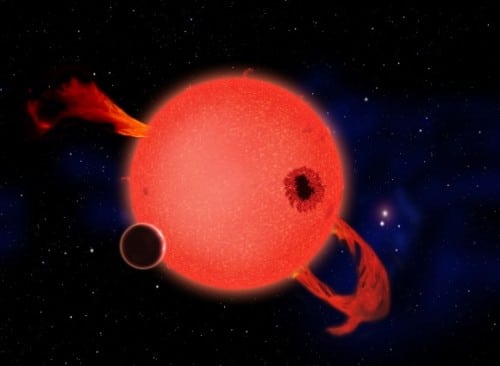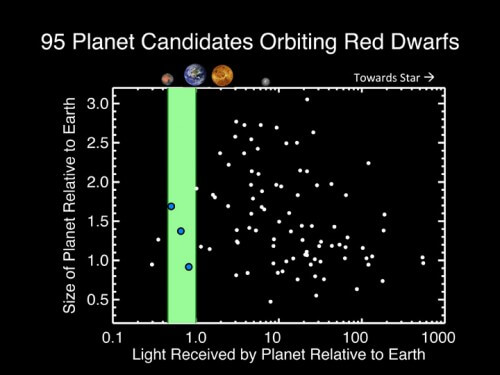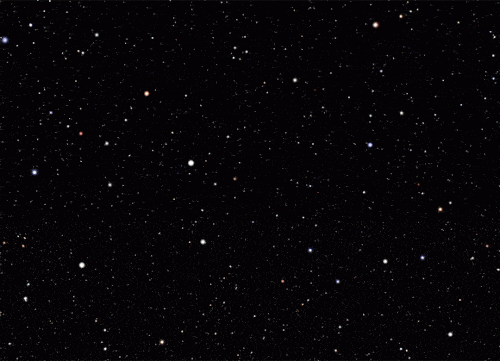This is according to a study presented by researchers at the Harvard Smithsonian Center for Astrophysics. Using the Kepler space telescope, they discovered 95 candidates for planets orbiting red dwarfs, three of which are in the habitable zone

We are literally surrounded by extraterrestrial planets with the potential for life. This is according to a new study published today, conducted by the team of the Harvard-Smithsonian Center for Astrophysics CfA.
The researchers, who used information collected by the Kepler space telescope, which specializes in hunting planets outside the solar system, discovered that many red dwarfs host a system of planets, and some of these planets are rocky planets about the size of Earth. Given that red dwarfs are dim sources of light in the visible light, and are also the most common type of star in our galaxy, this means that even if only a small percentage of solar systems have an Earth-like planet, the potential number of habitable worlds is very high – and some of them are actually Close.
Until now, we thought we would have to scan vast distances to find an Earth-like planet, says lead researcher Courtney Dressing. "We now understand that another planet is in our backyard, waiting to be discovered." And the backyard, in cosmic terms, could mean 13 light years away.
Red dwarfs are small, colder and paler than our Sun. The size of an average red dwarf is about a third of the Sun and its light intensity is only one thousandth. From Earth, no red dwarf is visible to the naked eye.
Our solar system is surrounded by red dwarfs. They cannot be seen in the night sky because they are very dim - less than one thousandth the brightness of the sun. However, they make up 75% of the stars in the local neighborhood, and based on the Kepler data, the team at the Harvard Smithsonian Center for Astrophysics estimates that 6% of the red dwarfs are surrounded by Earth-sized planets. "With at least 75 billion red dwarfs scattered throughout the galaxy, you'll do the math yourself."
Detecting planets orbiting red dwarfs would require a small space telescope or a large array of ground-based telescopes. Follow-up studies using the Large Magellan Telescope or the James Webb Telescope (the planned successor to the Hubble Space Telescope) will be able to tell us whether a hot planet is passing in front of its star and will also give us clues about its chemical composition.
Such a world would be very different from ours. It will orbit its sun so closely that there is a reasonable chance that it will be locked in its gravity and only one side will face it. However, this would not prevent life from forming because a reasonably thick atmosphere or deep ocean could transfer heat throughout the planet, and while a young red dwarf emits huge flames of ultraviolet light, an atmosphere could protect life on the planet's surface. In fact, such pressure may help the formation and development of life. "There is no need to clone the Earth to support life," Dresing said.
"We now know the rate of appearance of planets in the habitable zones around most common star types in our galaxy" says David Charbonneau, also from CfA and co-author of the paper. "This rate means that it will be easier to search for life beyond the solar system than we thought until now."

Conditions on a planet orbiting a red dwarf would be just like on Earth. Of course, the planet would have to orbit its sun at a much closer distance to be within the habitable zone, and it would have to have a thick enough atmosphere to moderate the heat and protect it from solar flares. However, one advantage of orbiting a red dwarf is that such a star has a much longer lifespan than the Sun, perhaps even longer than the current age of the universe, so the planet orbiting a red dwarf will have many billions of years to allow life to develop, thrive and survive on it. "It is possible that we will discover a twin to the Earth that is 10 billion years old" said Charbono.
The team's findings were presented yesterday (Feb. 6) during a press conference at the Harvard-Smithsonian Center for Astrophysics in Massachusetts. The results will be published in the Astrophysical Journal.


23 תגובות
Shlomi
The star you are talking about is not moving away from us at the speed of light. Therefore - 13 million years ago he was not close to us. 13.8 billion years ago he was indeed us....but the earth is "only" 4.5 billion years old.
A question from someone who doesn't understand - if the universe is in constant expansion, and the nearest stars that allow life are 13 million light years away from us, how do we know that one of these stars was not the Earth 13 million years ago?
The same Eric Verlind claims that there is no dark matter, and it is said: "MONDian behavior, it seems to explain/give a reason for MOND's free parameter (the acceleration a0) and he also showed that his approach can predict the ratio of baryonic to (phantom) dark matter correctly: 4% to 22.5%. That is, he is now trying to establish his theory of gravity by demonstrating scientific observations.
It's not in the margins - he received a prize of 2.5 million euros, but it still hasn't eliminated the dark matter theory.
In my opinion, this is his life's work, to assimilate his theoretical theory of gravity, in which gravity is a product of
Distribution of matter as a collection of points, and to unite it with general relativity, where the curvature of space will be explained as a statistical product of distribution of matter, and with quantum effects on the other side. Today it is very difficult to catch up with a new theory in the academic world, more so than in Einstein's time. The theory tests are much more difficult. Anthony Garrett Lizzi who united gravity with the E8 bunch of symmetry, failed to make a breakthrough against string theory.
In the same interview with him it was said:
"He even gave an explanation on why the centers of galaxy clusters deviate from the baryonic Tully-Fisher relation by a factor of four. The reason, he says, lies in the distribution of matter. Very roughly, galaxies can be approximated by a point mass if we look at their outskirts only. In galaxy clusters, however, the matter is more evenly distributed. Assuming a spatially constant matter density, he can even motivate the amount of the deviation
Avi: Is there an EMAIL address where I can write to you without sharing the site's content.
The scientist who showed that gravity can be derived from entropy is Eric Verlind.
It was said: "It appears that Verlinde's approach to explaining gravity leads naturally to the correctly observed strength of dark energy.[2] In June 2011, he was awarded the prestigious Spinoza Prize with a 2.5 million euro grant[3] for this work, including his paper.[4]". That is, there is an accepted theoretical physicist, who proposes a theory which he derives from simple entropy (density of matter), which leads to the fact that dark matter is not needed in the explanation.
I like your site very much.
There are a lot of things, but in areas where I am not well versed - and there are many of them I use volunteers for, and they are also not well versed in all areas. Actually the field of quantum physics is well covered by Dr. Gali Weinstein.
Just not caught. The cold and pure logic understands that in the infinite space there are other things similar to the earth and we are not alone. But the religious element in this part of the mind that we are supposed to be creatures of creation still does not allow us to free the mind and understand the meaning of this thinking. What makes the subject so complex is the death that interrupts in a single moment the ability to understand or live endlessly. If we were a stone with consciousness our situation would be different. We could have a dialogue with the first matter created in the universe. The inability to create life from matter leaves us in a dead place with great difficulty in understanding our very existence. As soon as science can create life from matter, faith in God will come to an end. And maybe the search for another life will be simpler. Will this moment come? I hope so.
There are theoretical developments in science that don't make it here, which is a shame. On the other hand, I have already seen
that the type of articles that attract talkbacks is more sensational, less scientific and theoretical. Articles about Henry III, the humanities do not get talkbacks. Articles about Earth-like stars gain many followers.
Examples that come to mind when I retrieve:
1. What is variable gravity, how do scientists deduce the force of gravity from the fact that the stars are accreted in the astronomical sense. Why a new star that changes the statistical distribution creates a gravitational pull of the saber
Resisting change.
2. Progress in quantum theory. Proof of a quantum model from a classical model where there is only temporal location. That is, temporary uncertainty.
3. Anthony Garrett Lizzi's model that unites gravity with the other 4 forces, against string theory. Couldn't shake the heads of the sips. How the E8 gang joins forces. That is, a higher order symmetry relation than was known so far, contains gravity. Why does it have no buyers?
4. Physics of condensed matter, and phase transitions. Power relations - how they arise from normalization. mathematical process
which allows: infinite calculation, and treatment of transition areas between one area of behavior and another.
The connection between Landau's Fermi liquid theory, the study of quantum semiconductors, and the study of economic behavior.
How did Landau manage to connect quantum theory with the behavior of a collection of particles without solving the Schrödinger equation with N particles.
Just talking.. So far they haven't found anything!
We'll live and see... 🙂 This is one of the things I don't like in modern science: the interpretations... "maybe" "maybe...". From a scientific point of view everything is possible and from a rational point of view it is also possible that aliens exist (although from a probabilistic point of view there is no chance for those who understand a little what I meant) but talk separately and reality separately... in short, we'll live and see!
To my father:
Regarding the dark matter. There are new theories called modified gravity where the attraction changes depending on the gravity distance scale. In this case no dark matter is required which has never been found.
A Google search will show how many academic articles there are on the subject.
There is a new theory in which gravity is derived from the entropy of a spreading, or static, collection of particles. In my opinion, this theory, moving in the direction of being the mainstream in physics (lacking observational evidence), will give the modified gravity content. How come the theory is moving to the mainstream? The same doctor in the Netherlands became a professor and established a research team on the subject. I think he also received a well-known award like Wolf or something like that. If there is a demand for it, I will refresh my knowledge and look for precise details on the subject. I think even on the science site.
Before everyone clamors to defend dark matter, let me just say that the emphasis is: there is another opinion and it is not on the margins.
The knowledge about dark matter is still in the mainstream of physics.
To Avi Cohen.
Your claim reinforces Yair's opinion. Genetic differences between our races are no more than 35 thousand years old,
The sunken eyes/compressed nose/short height or black color - this is their genetic distance.
and historical cultures no more than 1000 years (Germany, France, England or China/Korea, Cambodia and Vietnam) and in 2 there were wars and extinctions of peoples. A meeting between XNUMX interstellar civilizations when both are aware of each other, would be disastrous in my opinion. Unless it is such a spiritual civilization
who knows how to see the vitality in enabling primitive forms of life. Something in the style of a cocoon. I believe in the first option. The great distance isolates the cultures for good.
All conjectures and fantasies. Nevertheless, I believe that there is life on many other stars that are very, very far away from us, apparently they are so comfortable in their environment that we are here in a remote corner of no interest to them.
In response to Yair,
You forget one thing, both the Spaniards and the Indians, and you who draw this conclusion, are all members of the same race, which thinks in a certain way. It should not be assumed that another race will necessarily think the same way... So I hope they will be a little nicer than us and a little more optimistic, and then they will also manage to survive long enough to meet us...
melody,
National Geographic photographers also hide their presence when they photograph the animals in the wild, so that the animals behave naturally, and are not interested in the photographers... Would you behave naturally if you saw an extraterrestrial?
to dawn,
The dark matter they are trying to discover does not interact with the universe like normal matter we know, except gravity. I don't think all the planets in our system are a significant addition to the gravity of our sun for example...
Is it possible that the "dark matter" that they seek to locate/identify in space is nothing but (at least in part) billions of planets and their moons?
In response to "Comment to Yair" (Comment No. 4)
According to you, if a person is sent in the direction of an intelligent civilization, he should preferably be an archaeologist
so he can investigate her remains.
All of human history is full of descriptions of encounters with extraterrestrial civilizations, from India to the Indians of South America and of course the Middle East, you just have to look at things in a different light and then everything becomes clear.
I think that even if we find life elsewhere, chances are it will be primitive.
Because if we find a developed and advanced civilization like ours, why haven't they already visited us?
Some will say that they walk among us without us feeling it, because they have developed the ability to "see and be invisible", and they document us like animals in "National Geographic"! But in that case, they should be so developed that they should not feel threatened by us.
That is why I find it hard to believe that we will find an advanced civilization of our own.
And if such a civilization does exist, they will already find us 🙂
Shabbat Shalom
Because the Bible is also a history book. And it's not delusional. Do you know if there were meetings like the prophet Ezekiel's or Abraham's with the three angels. There were meetings of a company of those red dwarfs. And maybe one of them took divine ownership over us. Do you know?
13 light years... Wow, that's really close.
The problem with aliens is not only the distance, but the time differences.
If the stars are 10 billion years old and human culture is (and let's exaggerate on purpose) a hundred thousand years old, then the window of time for a "meeting" between the cultures is very, very small. Even if we find such a star, then the chances are that we will find primitive creatures on it or the remains of a culture that became extinct and may have already been wiped out from the earth millions and possibly billions of years ago (and then we may find fragments of dust from them..).
I have no doubt that there is extraterrestrial life and that somewhere there are aliens or there were aliens, I simply doubt that we will ever find something that "looks like us" somewhere in space. I'm also not sure that this meeting will end well, just like the meeting between the advanced Spaniards and the inferior Indians ended very badly for the Indians, and this is another meeting between members of the same species... in short, fascinating.
It turns out that abami are much less absurd than many people think. If at a distance of 10-20 luminaries intelligent life exists for hundreds of millions of years, they could obtain technologies that here cannot even be dreamed of, and what's more, they had a lot of time to fly.
Certainly, when it comes to the future there is no limit...
"Maybe even bigger than the current age of the universe" -?????